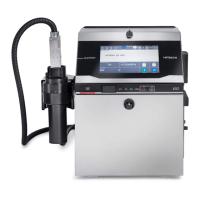39
4.3.2. Speed Matching Function Using Rotary Encoder
The speed matching function is used when the speed of a print target or the speed of the conveyor carrying the
target changes while printing is in progress in the IJ Printer. Without this function, a change in the speed may
change the width of characters to be printed, causing the difficulty in reading them.
To use the function, you need to input an electrical pulse with a period proportional to the speed to the IJ
Printer from the outside. The rotary encoder is generally used for this purpose. The rotary encoder detects the
speed by connecting it to the conveyor shaft or touching the surface of the conveyor belt.
The IJ Printer can print vertical lines of a print message in synchronization with pulses from the rotary
encoder.
4.3.2.1. Specifications and Wiring of Rotary Encoder, and Switch Settings
(1) The specifications of the rotary encoder that can be connected are described below.
– Output waveform: Square wave (duty: 30 to 70 %)
– Output withstand voltage: 24 VDC or more
– Load current: 20 mA or more
– Leakage current: 0.1 mA or less
– Power supply voltage: 24 VDC
– Current consumption: 100 mA or less (*)
(The current consumption of the rotary encoder and sensor is 100 mA
or less in total when the IJ Printer built-in power supply is used.)
– Input signal frequency: 200 kHz or less
– Number of pulses: Depending on production line conditions
(*): The maximum capacity of the IJ Printer built-in power supply (24 VDC) is 100 mA.
When the current consumption of the sensor and encoder exceeds 100 mA, or when the
power supply voltage is not 24 V, use a dedicated power supply and connect wires as
shown in (3).

